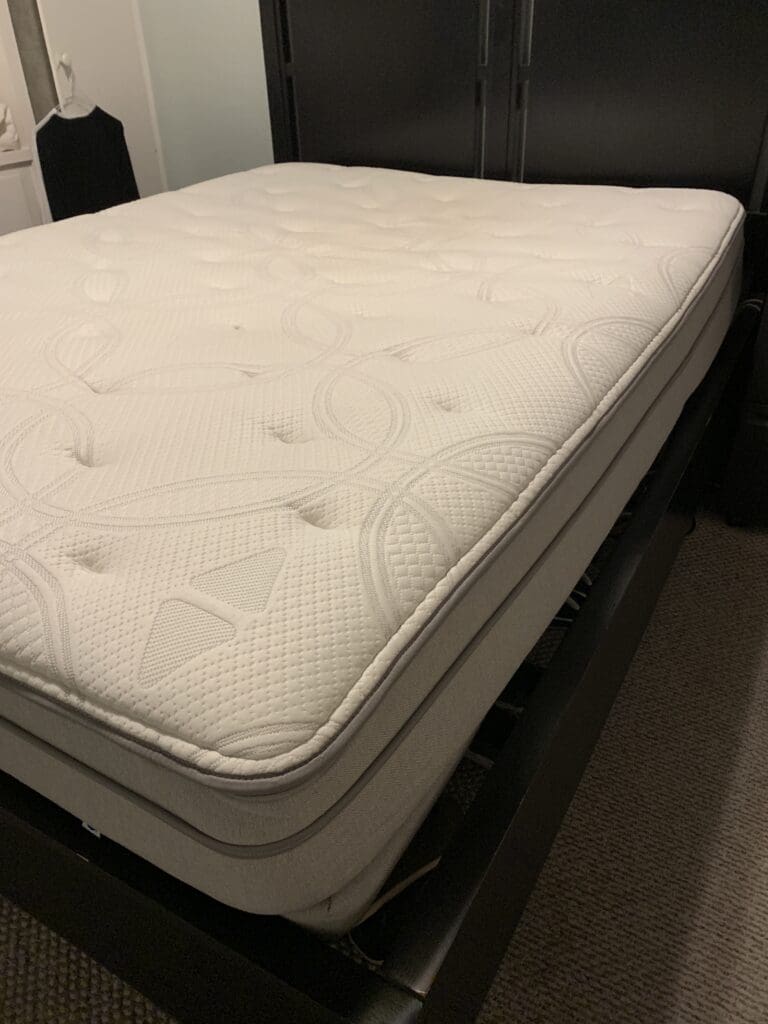We all know a well-supported
You can get a platform bed frame or an adjustable bed for a sleek aesthetic and optimal support. Alternatively, you can keep things simple by just adding wooden slats or bunkie boards.
Continue reading to find out what box springs are, their history, how and why they’re used, and then learn more about the modern alternatives!

Before I get into the alternatives to box springs, it’s important to know about their intended function. This will help you understand what to look for when substituting it.
To begin with, spring boxes were invented near the end of the 19th century to support innerspring mattresses. That’s why, back in the day, they were mostly sold as a package.
In case you didn’t know, an innerspring
As time went on, several benefits of using spring boxes came to light, such as:
The standard height of a spring box is about 9 inches, and the low profile one is around 5 inches. These extra inches raise the bed, putting the
A box spring is a sturdy wooden frame that contains springs or a metal grid and is the same size as your bed.
It’s easy to see how this can provide adequate support for mattresses, specifically those placed on beds that aren’t designed to carry mattresses on their own, such as the traditional metal bed frame.
Box springs aren’t compact structures; instead, they’re somewhat hollow. This allows air to circulate properly beneath the
Primarily, it prevents moisture accumulation, which can lead to mold growth. Allowing air to circulate keeps things from getting moldy over time and can also keep your
Shock absorption is a key feature of box springs. This means it takes in some of the force exerted on the
In fact, because of this, some
If you’ve ever been in the market to buy a new

Now that you know the benefits of box springs, you can see why they’re necessary for a good night’s sleep. Yet, they’re not the best option for everyone. There can be a handful of problems associated with box springs.
If you’ve ever used a box spring for along period of time, you know they can break down and become uncomfortable. Sometimes there can be an issue because the
Having dealt with some of these issues myself in the past, I decided to compile a list of five alternatives that offer all or some of the advantages of spring boxes, but with a modern twist!
Starting with one of the most popular options on the market. A platform bed frame might hurt your wallet, but it’s well worth the investment.
Platform beds are basically bed frames with a solid surface that can be slatted wood, metal, or another framework. This surface serves as the
The great thing about platform beds is that they come in a variety of shapes and designs. Most of them have a contemporary flair that most of us love. They can. also provide storage space, which box springs don’t.
With these bed frames, you get all the benefits of box springs and more. However, most of their designs don’t offer the same increased height as box springs, as they’re usually a little lower.
There are bed frames that come with their own wooden slats, or you can get them separately. In any case, they’re an excellent choice for anyone on a tight budget.
These slats are spaced 1.5-2 inches apart to allow air to reach the
As a piece of advice, opt for fir or pine wood; they’re both sturdy and reasonably priced. It’s also a good idea to use thin slats that are 3-4 inches wide so that you can easily move them around when storing the bed or redesigning the room.
Adjustable beds are worth considering if you don’t mind splurging on a bed frame. They not only have designs that complement any bedroom decor, but they’re also extremely practical alternative to box springs.
These beds have multiple controls to help you adjust them to the desired position; yes, they’re similar to those found in hospitals. This makes them a fantastic choice for anyone who enjoys sitting comfortably on a bed to watch TV or read.
This type of bed is also convenient for the elderly or those with medical conditions that require specific sleeping positions. For instance, sleeping upright or with their head elevated is more comfortable for people with chronic obstructive pulmonary disease.
Additionally, these beds have a firm base for the
Bunkie boards, as the name implies, were originally used to support mattresses in bunk beds. They’re durable and didn’t add much height to the bed, so they were a good fit. They’re simply boards of thin wood, about 2 inches thick, covered in fabric.
You can use these boards alone or pair them with slats for added support. They won’t raise your
One drawback of using bunkie boards is that they don’t provide adequate airflow like the other structures on this list.
If your bed frame has a solid platform that supports the
This pad’s mainly made of coconut fiber mixed with natural latex. We can thank this eco-friendly combo for the remarkable air circulation that this pad creates.

You’ve probably seen the idea of laying the
What’s more appealing is that you won’t have to pay a dime for any supporting structure. The floor acts as a firm foundation for the
However, as we move on to the not-so-bright side of this idea, we’ll discover a few downsides. Here are the three of them:
I’ve been stressing the importance of allowing air to reach beneath the
As it’s lying there, there’s less chance of air circulating and a higher chance of bacteria as well as mold growth. That’s why you’ll often see people doing this have their
Having your
Sleeping in chilly environments has already been shown to disrupt your sleep cycle. So, if you live somewhere with bitterly cold temperatures, I suggest investing in a bed frame.
Maintaining proper hygiene while your
Consequently, you’ll need to keep your
There are many excellent box spring alternatives. The best option for you will entirely depend on the benefits you seek, your taste, and your budget.
If you decide to take a chance and leave the